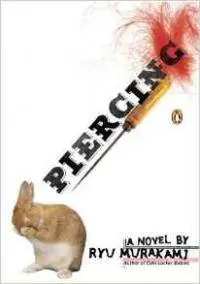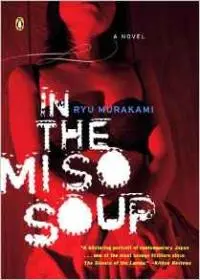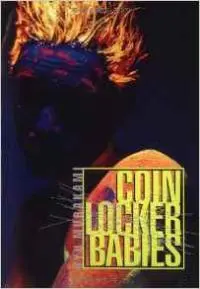Image via Pushkin Press
You might be familiar with Ryu Murakami even if you don’t think you are, thanks to the popularity of Takashi Miike’s Audition. Whenever Japanese horror films are mentioned, Audition is at the centre of the discussion alongside the likes of Ju-On, Ringu and Dark Water. If you’ve been fortunate enough to see Audition you’ve had a glimpse into the mind of Ryu Murakami – nuanced, unfiltered and at times depraved. Murakami presents to us real characters, with real albeit unusual problems. Often these characters are deeply troubled, painted with a palette of greys. Murakami often punctuates his fiction with jet black humour, his stories – while sometimes following conventional narrative structure – are only ever snapshots of a wider tale, which speaks volumes to his fully realised worlds and characters, as opposed to being a detriment to the story.
Who is Ryu Murakami?
Ryu Murakami was born in Sasebo, Nagasaki on 19 February, 1952. He’s a novelist, essayist and filmmaker. Sometimes dubbed the ‘renaissance man for the modern age’, his Japan-based stories explore themes of disillusionment, drug use, surrealism, murder and war. Murakami’s success transcends the page. A fan and lifelong advocate of Cuban music, he introduced it to Japan and even established his own record label: Murakami's in Sony Music.
Ryu Murakami has penned over thirty novels, eight of which have been translated into English. English language readers can enjoy a further three translations of short stories, all thanks to Ralph McCarthy, who’s also responsible for translating six of Murakami’s novels. Thanks should also go to Pushkin Press, who in 2013 published four Murakami English translations.
What did I spend my month reading?
'Piercing'
Originally published in 1994.
English translation by Ralph F. McCarthy, published in 2007.
My introduction to Ryu Murakami was loud, sharp and anything but subtle. You could say it was like being stabbed with an ice pick, which brings us to the subject matter. The story begins with our protagonist, Kawashima Masayuki, watching his infant child sleep. He retrieves an ice pick from his pocket and assures himself he won’t stab his baby. This is the tenth night he’s performed this ritual, watching over his sleeping child, ice pick in-hand, while his wife sleeps peacefully, oblivious.
Gripping the ice pick lightly to minimise trembling, he placed the point of it next to the baby’s cheek… It really is all right, I’m not going to stab the baby.
–Piercing, Ryu Murakami
 Kawashima has suffered from life-long anxiety. He found temporary escape from it when he previously stabbed an ex-lover. But as the novel opens his anxiety is intensifying and he needs to control it. He keeps telling us – and himself – that he won’t bludgeon his own child. It’s not the proper course of action. But he must do something. He discovers a solution, to stab a prostitute. He plans the details meticulously, weighing up the different types of hotels, the location and even the clothes he’ll wear. He wants to disguise himself in some way to make him unrecognisable, but also considers how he can’t stand out for fear of becoming memorable. Having seemingly considered every eventuality, Piercing ramps up the intrigue when we’re introduced to the prostitute in question, Sanada Chiaki. It turns out that Sanada has a more complex past than Kawashima, coloured by abuse, tragedy and mental health issues.
Kawashima has suffered from life-long anxiety. He found temporary escape from it when he previously stabbed an ex-lover. But as the novel opens his anxiety is intensifying and he needs to control it. He keeps telling us – and himself – that he won’t bludgeon his own child. It’s not the proper course of action. But he must do something. He discovers a solution, to stab a prostitute. He plans the details meticulously, weighing up the different types of hotels, the location and even the clothes he’ll wear. He wants to disguise himself in some way to make him unrecognisable, but also considers how he can’t stand out for fear of becoming memorable. Having seemingly considered every eventuality, Piercing ramps up the intrigue when we’re introduced to the prostitute in question, Sanada Chiaki. It turns out that Sanada has a more complex past than Kawashima, coloured by abuse, tragedy and mental health issues.
It’s at this point that Piercing becomes a black comedy, as both characters plot against the other, making poor judgements along the way due to their paranoia and false assumptions. Up until the introduction of Sanada, the plot – on the surface – is a very simple one and everything points towards the story culminating with the titular ‘piercing’. Of course, we knew it would never be that simple, but Sanada really is a game changer and all previous rules and preconceptions evaporate.
There’s a lot to like about Piercing, and many facets make this an essential read. Murakami’s decision to concentrate, almost exclusively, on just two characters and a time period of little more than twenty-four hours makes Piercing an intimate and punchy read. The fast-pace and constant intrigue will no doubt see most readers consume Piercing in just one or two sittings. Amongst the graphic violence – which is never gratuitous – and the edgy humour are mundane details of everyday life. The smell of homemade cooking and freshly baked bread that wafts around Kawashima’s humble abode, thanks to his wife’s bakery classes, contrasts perfectly with the violence and anger. Piercing is one of the best books I’ve read in 2015 and I recommend you check it out, too.
'In The Miso Soup'
Originally published in 1997.
English translation by Ralph F. McCarthy, published in 2007.
Piercing is a tough act to follow, but if any book was capable of matching it, I felt it was In The Miso Soup. It won the Japanese literary award, the Yomiuri Prize, in 1997 and is easily the most talked about Murakami novel in the western world. It’s enjoyed a plethora of rave reviews from major newspapers and magazines in both the UK and USA, and is considered by many a cult classic and standout example of Japanese genre fiction. Much like Piercing it’s a slender read at just over two-hundred pages, and the subject matter is satisfyingly dark.
It was murder with all the drama of picking up a fallen hat and replacing it on a rack.
–In The Miso Soup, Ryu Murakami
 As with Piercing, Murakami has made the decision to focus on just a couple of characters, though this time around there are more minor players. Our story is told from the perspective of Kenji, a nightlife guide. The job, whilst not strictly legal, is what you may well anticipate – he gives gaijin guided tours of underground Japan, focussing primarily on the sex industry in and around Roppongi. With Kenji’s encyclopaedic knowledge of the area and a large list of contacts he’ll ensure his clients find what they’re looking for, provided they have the cash to meet both Kenji’s fees and any drinks he might consume. Taking part in the run-up to and during New Year’s Eve, Kenji’s client is loud-mouthed American, Frank. The only thing bigger than his misguided confidence is his waistline. Kenji has a bad feeling about Frank from the get-go. So much so that he believes Frank is somehow connected to the bloody murders of both a local schoolgirl and a vagrant. But intuition isn’t evidence and Kenji needs the money so he continues to work with Frank. As the story deepens so too do Kenji’s suspicions. Frank starts to lie about the most mundane of things, begins to contradict himself when regaling Kenji with tales of his childhood. What perplexes Kenji most is that Frank lies about trivial details, lies for seemingly no reason. Then Frank begins to experience episodes in which his mind appears to disconnect from his body and he feels nothing but anger. He starts to scare Kenji and local sex workers. He also reveals he has the ability to hypnotise people, which brings with it all manner of terrifying possibilities. Kenji knows he needs to distance himself from Frank, but is in too deep, and Frank’s increasingly erratic behaviour complicates matters exponentially. We don’t know, at this point, whether Frank is connected with the local murders but we do know that Kenji is risking his life in staying around Frank, and we also know that Murakami’s narratives are anything but linear which further elevates the tension.
As with Piercing, Murakami has made the decision to focus on just a couple of characters, though this time around there are more minor players. Our story is told from the perspective of Kenji, a nightlife guide. The job, whilst not strictly legal, is what you may well anticipate – he gives gaijin guided tours of underground Japan, focussing primarily on the sex industry in and around Roppongi. With Kenji’s encyclopaedic knowledge of the area and a large list of contacts he’ll ensure his clients find what they’re looking for, provided they have the cash to meet both Kenji’s fees and any drinks he might consume. Taking part in the run-up to and during New Year’s Eve, Kenji’s client is loud-mouthed American, Frank. The only thing bigger than his misguided confidence is his waistline. Kenji has a bad feeling about Frank from the get-go. So much so that he believes Frank is somehow connected to the bloody murders of both a local schoolgirl and a vagrant. But intuition isn’t evidence and Kenji needs the money so he continues to work with Frank. As the story deepens so too do Kenji’s suspicions. Frank starts to lie about the most mundane of things, begins to contradict himself when regaling Kenji with tales of his childhood. What perplexes Kenji most is that Frank lies about trivial details, lies for seemingly no reason. Then Frank begins to experience episodes in which his mind appears to disconnect from his body and he feels nothing but anger. He starts to scare Kenji and local sex workers. He also reveals he has the ability to hypnotise people, which brings with it all manner of terrifying possibilities. Kenji knows he needs to distance himself from Frank, but is in too deep, and Frank’s increasingly erratic behaviour complicates matters exponentially. We don’t know, at this point, whether Frank is connected with the local murders but we do know that Kenji is risking his life in staying around Frank, and we also know that Murakami’s narratives are anything but linear which further elevates the tension.
In The Miso Soup is written at the same frenetic pace and in the same compulsive style as Piercing. It is a book that is as quick to devour, though in knowing less about Frank and his intentions the tension and fear is all the more real. Having seen how Piercing pit two troubled characters against one another, I was wary Kenji might turn out to be an unreliable narrator and was mindful not to take anything at face value. I also got a huge buzz out of the references to Japan and Tokyo. Having lived there previously, there was a real delight in reading about experiences in places I’m familiar with (not that I’m intimately acquainted with Tokyo’s sex culture…).
'Coin Locker Babies'
Originally published in 1980.
English translation by Stephen Snyder, published in 1995.
At over five-hundred pages, it was obvious Coin Locker Babies was going to be a different beast entirely from Piercing and In The Miso Soup. I must admit when I read the opening line on the metro back from work I held the book closer to me, concealing it from other passengers, and wondered what I’d gotten myself into.
The woman pushed on the baby’s stomach and sucked its penis into her mouth; it was thinner than the American menthols she smoked and a bit slimy, like raw fish.
–Coin Locker Babies, Ryu Murakami
I’ve read some messed up books in my time and some books that crush taboos and delve into disturbing subject matter. We’re talking The End of Alice, The Girl Next Door, Tampa, The Venus Complex, I could go on… but that line knocked me back. Holy shit, talk about a controversial, gutsy opener to your novel. This was only Murakami’s third novel, too, and he’d stamped his intent from the off.
 Coin Locker Babies is a bildungsroman that focuses on our almost-brothers protagonists, Hashi and Kiku. Both boys were abandoned as babies and locked in coin lockers at a station in Tokyo in the 1970s.Upon their discovery and miraculous survival, they were raised at the Cherryfield Orphanage in Yokohama, then later adopted by the Kuwayamas. The stronger of the two, and naturally athletic, Kiku, becomes a world-class pole-vaulter, but he also becomes obsessed with DATURA, a poisonous drug he believes has the capability to destroy Tokyo. Meanwhile, Hashi, has transformed into a cross-dressing rockstar and forms a dubious relationship with his manager, Mr. D.
Coin Locker Babies is a bildungsroman that focuses on our almost-brothers protagonists, Hashi and Kiku. Both boys were abandoned as babies and locked in coin lockers at a station in Tokyo in the 1970s.Upon their discovery and miraculous survival, they were raised at the Cherryfield Orphanage in Yokohama, then later adopted by the Kuwayamas. The stronger of the two, and naturally athletic, Kiku, becomes a world-class pole-vaulter, but he also becomes obsessed with DATURA, a poisonous drug he believes has the capability to destroy Tokyo. Meanwhile, Hashi, has transformed into a cross-dressing rockstar and forms a dubious relationship with his manager, Mr. D.
Coin Locker Babies isn’t as instantly rewarding as Piercing or In The Miso Soup and is infinitely more complex, owing to its larger cast of characters and multiple storylines. It is perhaps the most ‘bat shit nuts’ (definitely a literary term) of Murakami’s books though. Case in point, Kiku’s girlfriend Anemone is a model who converts her humble condominium into a tropical swamp for her pet crocodile! There’s a lot of stream of consciousness and exposition to endure in Coin Locker Babies, but if you can persist through these tangents, and even take delight in them, you’ll love (perhaps not the right word) the chaotic ending.
Some consider Coin Locker Babies Murakami’s masterpiece, but for me it doesn’t quite hit the resounding highs that Piercing and In The Miso Soup reach, its ambition being a little higher than its execution. That said there’s a lot to enjoy here and The Washington Post pull-quote is spot on, “A great big pulsating parable . . . wildly undisciplined, occasionally tongue-in-cheek.”
'Sixty-Nine'
Originally published in 1987.
English translation by Ralph F. McCarthy, published in 2013.
The first thing you’ll notice is the unsubtle sexual connotation of the title. Delve into it for a couple of chapters and you’ll see this is a much more linear and less experimental piece than Coin Locker Babies. A lot more palatable and easier to digest, and slimmer, too, at just shy of two-hundred pages. Sixty-Nine is a roman à clef that begins in (surprise, surprise) 1969 and spans eighteen months. It focuses on seventeen-year-old Kensuke Yazaki and his group of friends. Their main interests – as you might expect – are girls, rock music and art (in all its guises). Despite its political and social commentary, everything Ken does is to impress the girl he fancies, from vandalising his school to starting a ‘revolution’ to organising and putting on ‘The Morning Erection Festival’. Sixty-Nine reads at times like a love letter to the western world from Japan, but it lacks the depth of Coin Locker Babies or the brutality of Piercing and In The Miso Soup.
The Rest
'Almost Transparent Blue'
Originally published in 1976.
English translation by Nancy Andrew, published in 1977.
A Japanese mix of A Clockwork Orange and L'Etranger.
–Newsweek
'Popular Hits of the Showa Era: A Novel'
Originally published in 1994.
English translation by Ralph F. McCarthy, published in 2013.
One of the funniest and strangest gang wars in recent literature.
–Booklist
'Audition'
Originally published in 1997.
English translation by Ralph F. McCarthy, published in 2009.
The prose in these passages is elegiac and affecting, but it has the sharp, visceral feel of the butcher's knife or surgeons scalpel, a highly compulsive, one-sitting read, and Audition should add to the Renaissance Man's growing fanbase in the English speaking world.
–Irvine Welsh
'From the Fatherland, with Love'
Originally published in 2005.
English translation by Ralph F. McCarthy, Charles De Wolf and Ginny Tapley Takemori published in 2013.
A troubled meditation on the soul of modern Japan… Alarmingly pertinent in light of current British politics… A morbidly funny comedy… Above all, it is a phenomenal feat of storytelling: 700 pages, dozens of characters and scores of ideas woven into one gripping whole.
–Metro
Any Murakami fans out there? Where do you recommend the uninitiated start?

About the author
Michael David Wilson is the founder of the popular UK horror website, podcast, and publisher, This Is Horror. Michael is the author of the novella, The Girl in the Video, and the novel, They’re Watching, co-written with Bob Pastorella. His second novella, House of Bad Memories, lands in 2021 via Grindhouse Press. His work has appeared in various publications including The NoSleep Podcast, Dim Shores, Dark Moon Digest, LitReactor, Hawk & Cleaver’s The Other Stories, and Scream. You can connect with Michael on Twitter @WilsonTheWriter. For more information visit www.michaeldavidwilson.







